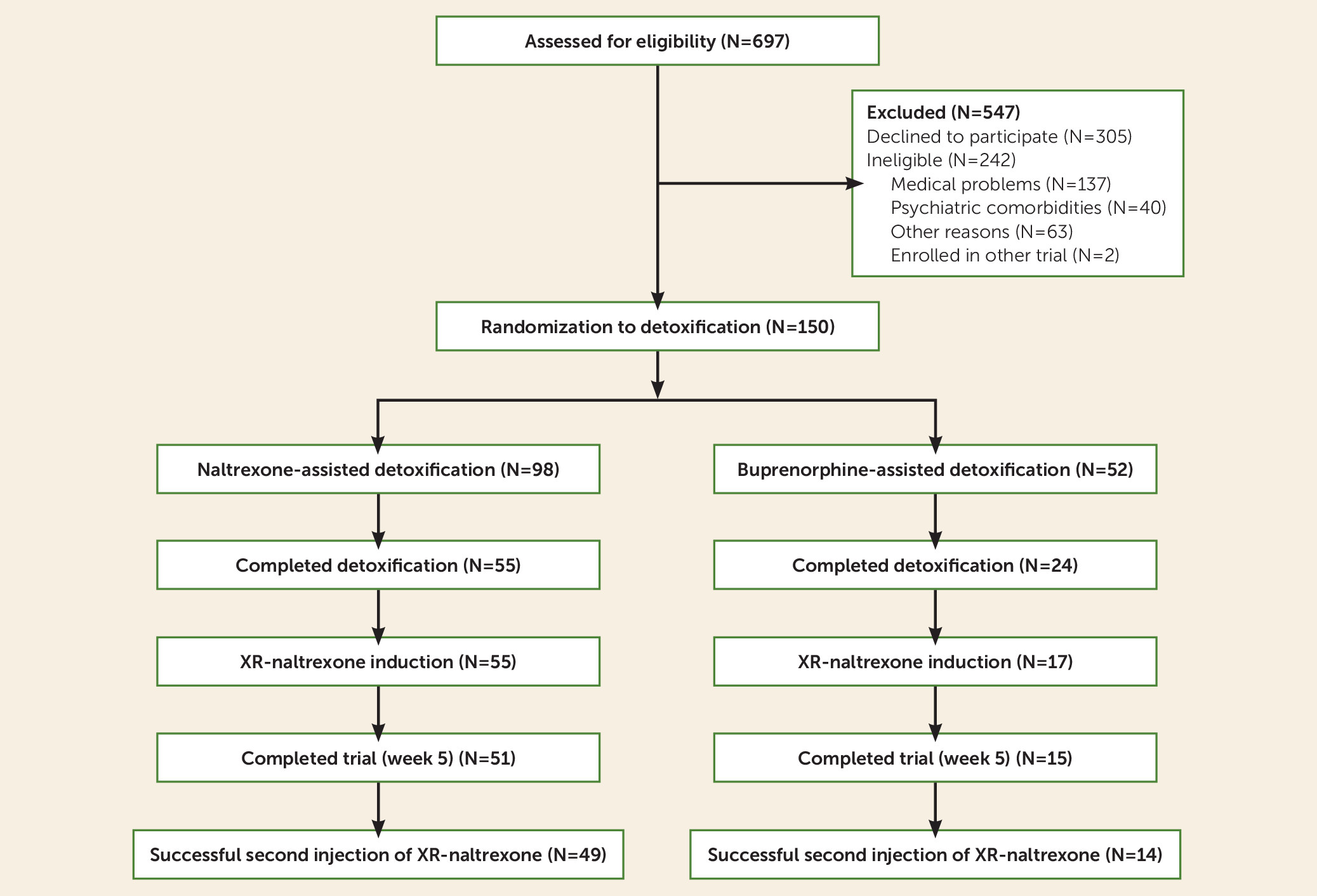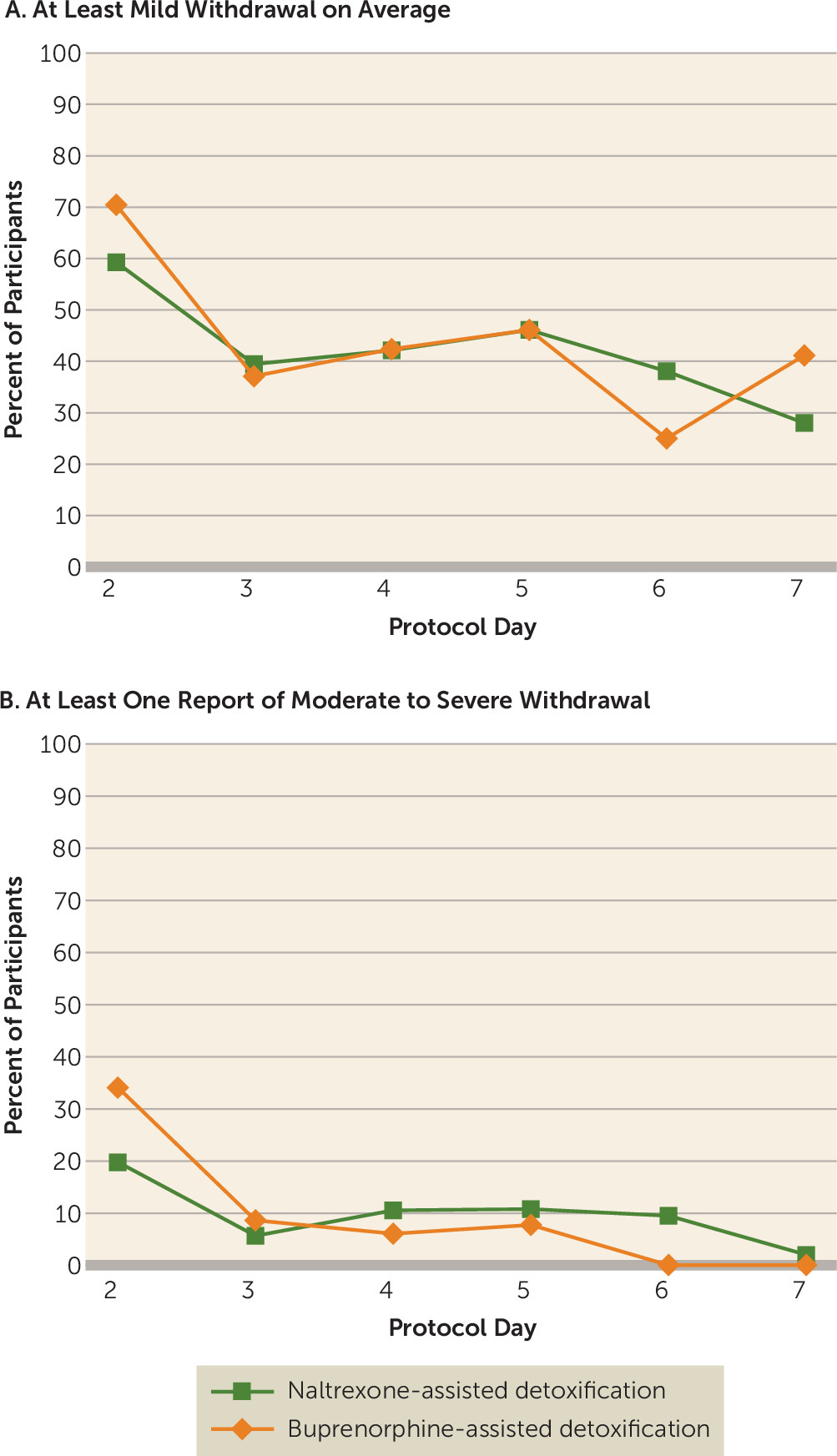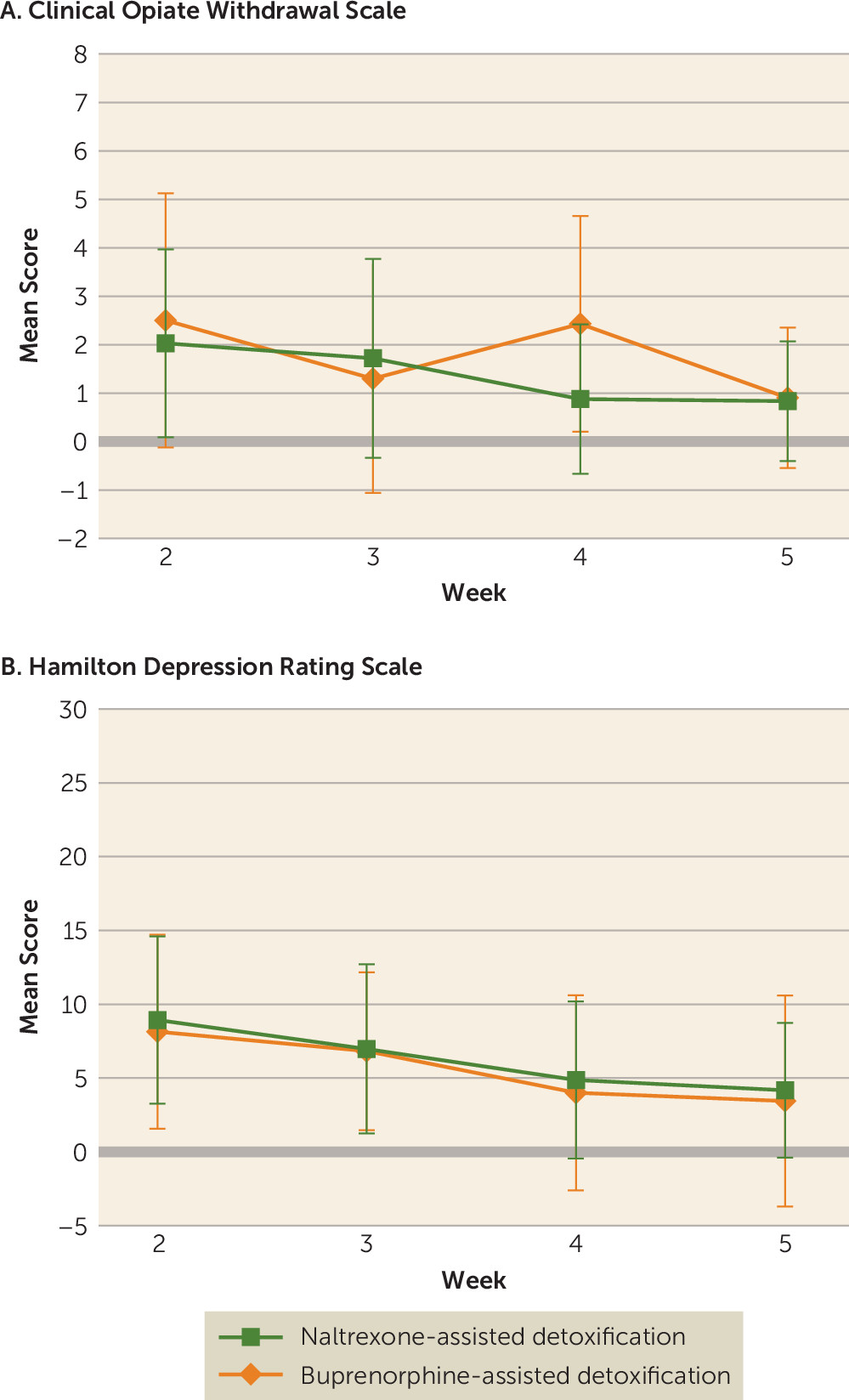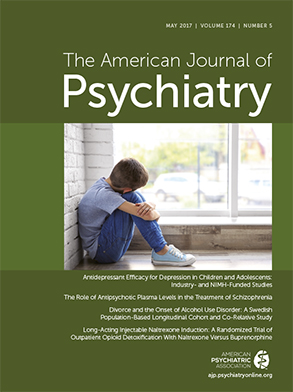The United States is currently in the midst of an opioid epidemic. It has been estimated that in 2014, more than 4.3 million people were current nonmedical users of prescription pain relievers, and 435,000 people used heroin (
1). Correspondingly, sharp increases in opioid overdose deaths and emergency department visits have been reported in the past decade (
2). Increased availability of illicitly manufactured synthetic opioids has contributed to sharp rises in “prescription opioid” deaths, since illicit fentanyl cannot be distinguished from prescription fentanyl on death certificates (
3).
An extended-release injectable form of naltrexone (XR-naltrexone) (
4,
5) has U.S. Food and Drug Administration (FDA) approval for relapse prevention following opioid detoxification. However, a substantial barrier to its effective implementation is the need to detoxify patients from opioids before naltrexone is initiated. The official prescribing information (
5) recommends that individuals abstain from opioids for 7–10 days before receiving an XR-naltrexone injection to avoid precipitated withdrawal. This waiting period, combined with conventional methods of opioid detoxification employing agonist tapers over several days, represents a delay of 2 weeks or more before XR-naltrexone can be administered. This is feasible during an extended residential treatment stay; however, the availability of inpatient detoxification beds is decreasing, and patients are increasingly seeking treatment in outpatient settings (
6). Unfortunately, outpatient opioid detoxification with traditional agonist tapering is associated with significant attrition and high relapse rates (
6–
9) resulting from craving for opioids (
10), withdrawal symptoms (
11), and the delay in initiation of XR-naltrexone following detoxification. Thus, new outpatient methods are needed to shorten the delay to XR-naltrexone induction.
Various detoxification regimens that include opioid antagonists were first proposed in the 1980s to accelerate transition to treatment with naltrexone (
12–
17). Common to many is initiation of oral naltrexone at low doses and a gradual dosage increase along with nonopioid ancillary medications to alleviate withdrawal symptoms that might be precipitated with naltrexone. Safe transition from opioid agonists to naltrexone in 1 week has been demonstrated (
15,
18,
19). In earlier trials over the past two decades (
14,
16,
20–
25), we developed and modified a 7-day detoxification regimen combining single-day buprenorphine with low doses of oral naltrexone and standing ancillary medications. Recently, Mannelli and colleagues, building on animal (
26) and human studies (
27,
28) on opioid detoxification, conducted a pilot study (
29) with simultaneous administration of buprenorphine and very low doses of oral naltrexone to initiate XR-naltrexone in an outpatient setting. However, to our knowledge, no controlled trials have compared accelerated detoxification methods with a more standard taper of methadone or buprenorphine followed by a 7- to 10-day waiting period, as recommended by the official prescribing information for XR-naltrexone.
We conducted a randomized trial in participants seeking treatment for heroin or prescription opioid dependence, comparing two outpatient regimens: 1) rapid induction consisting of one day of buprenorphine administration followed by ascending doses of oral naltrexone (naltrexone-assisted detoxification) plus nonopioid ancillary medications, and 2) a standard 7-day buprenorphine taper followed by a 7-day delay to first XR-naltrexone dose (buprenorphine-assisted detoxification). We hypothesized that participants assigned to the rapid naltrexone-assisted detoxification would have a higher rate of XR-naltrexone induction compared with those undergoing buprenorphine-assisted detoxification. We also hypothesized that episodes of severe withdrawal would be more frequent in the rapid induction group.
Method
Participants
Opioid-dependent individuals (ages 18–60) seeking treatment were evaluated at an outpatient research clinic using the Mini International Neuropsychiatric Interview (
30) and a clinical interview assessing substance abuse severity. Medical evaluation included history, physical examination, laboratory tests, and ECG. The Institutional Review Board of New York State Psychiatric Institute approved the study, and all participants gave written informed consent.
The target enrollment was 150 participants who met DSM-IV criteria for current opioid dependence of at least 6 months’ duration and were able to give informed consent. Individuals with unstable medical or psychiatric disorders were excluded. Other exclusion criteria included physiological dependence on alcohol or sedative-hypnotics, a history of accidental opioid overdose within the past 3 years, treatment with opioids for chronic pain, and regular use of methadone or buprenorphine.
Study Procedures
Randomization.
Participants were randomly assigned on day 1 to naltrexone-assisted detoxification or buprenorphine-assisted detoxification in an open-label, parallel-group, outpatient clinical trial. Randomization was carried out by a staff statistician not otherwise involved in the study. Participants were stratified by severity of opioid dependence—low use (≤5 bags of heroin or ≤200 mg of morphine equivalents per day) and high use (>5 bags of heroin or >200 mg of morphine equivalents per day)—because baseline severity has predicted success of naltrexone induction in previous studies (
21,
31). (A “bag” was estimated to contain 10 mg of heroin, equivalent to 20 mg of morphine intranasally or 40 mg of morphine orally.) Within each severity stratum, participants were randomly assigned 2:1 to naltrexone-assisted detoxification (N=98) or buprenorphine-assisted detoxification (N=52) to allow a closer examination of the safety and efficacy of the naltrexone-assisted regimen.
Detoxification protocols.
Study medications (buprenorphine, naltrexone, and adjuvant medications) were administered on-site in an open-label manner, and daily take-home doses were dispensed as needed during the detoxification week. In both treatment arms (
Table 1), participants were assessed daily (Monday through Friday) on days 1–8 for substance use, vital signs, withdrawal symptoms, and opioid craving. They were instructed to abstain from opioids for 12–24 hours prior to arriving at the clinic on day 2 in mild to moderate withdrawal, measured using the Clinical Opiate Withdrawal Scale (
32). Participants with a score ≥6 received an initial buprenorphine dose of 2 mg; if it was well tolerated, subsequent 2-mg doses were administered every 1–2 hours, titrating up to a total dose of 8 mg.
Participants assigned to the naltrexone-assisted detoxification treatment arm followed a buprenorphine-clonidine-naltrexone procedure (
12,
22,
33,
34), as modified on the basis of our experience (
14,
16,
20–
25,
31). On day 3, participants began standing doses of clonidine (0.1 mg q.i.d. plus 0.1 mg every 4 hours as needed, up to 1.2 mg/day) and clonazepam (0.5 mg every 6 hours, up to 2 mg/day), which continued until day 8. On day 4, after pretreatment with 10 mg of prochlorperazine, oral naltrexone was started at a dose of 1 mg, with increasing daily doses given through day 7 (3 mg, 12 mg, 25 mg). On day 8, having tolerated 25 mg of naltrexone on the previous day, participants received an intramuscular injection of 380 mg of XR-naltrexone.
Participants in the buprenorphine-assisted detoxification group received decreasing daily doses of buprenorphine (8 mg to 1 mg) on days 2–7, followed by a 7-day opioid washout period before XR-naltrexone administration on day 15. Participants who completed the buprenorphine taper and remained in treatment for the subsequent 7 days were eligible for the naloxone challenge test (0.8 mg i.m.), and if no withdrawal emerged, they received an intramuscular injection of 380 mg of XR-naltrexone. Participants undergoing buprenorphine-assisted detoxification were not offered standing doses of adjuvant medications, but adjuvant medications were given if deemed clinically necessary.
Postinduction treatment phase.
In both treatment arms, participants received outpatient treatment for 4 weeks, and those retained at week 5 were offered an additional XR-naltrexone injection. Participants were offered adjuvant medications for 1 week following administration of XR-naltrexone to alleviate residual withdrawal symptoms. During each visit, on-site urine toxicology was performed for opioids, psychostimulants, and benzodiazepines; one sample weekly was sent to the laboratory for confirmation testing. Participants met weekly with a research psychiatrist to monitor treatment progress and review medication tolerability and adherence. All participants attended twice-weekly individual therapy sessions that included elements of motivational interviewing, relapse prevention, and cognitive-behavioral therapy (
24,
25). Participants were reimbursed for travel and assessments, up to a maximum of $680 in potential earnings across the study.
Subsequently, participants were offered an extension phase of the study, during which referrals to continue treatment in community programs were initiated as deemed clinically appropriate and in accordance with the patient’s wishes.
Assessments and Data Analysis
The primary aims of this study were 1) to compare the odds of successful XR-naltrexone induction between the two treatment arms and 2) to compare the odds of receiving a second XR-naltrexone injection at week 5 between the two treatment arms. Both primary outcomes were modeled using logistic regressions with main effects of treatment and adjusted by covariates: morphine equivalents of opioids being used at baseline, primary type of opioid use at baseline (heroin versus prescription opioids), and route of opioid administration (intravenous versus non-intravenous routes). Dropout during detoxification or the postinduction phase was considered as failing to receive the scheduled XR-naltrexone injection; dropout is a main failure mode in the treatment of opioid dependence, and it is most often accompanied by relapse to opioid use.
Secondary outcomes were 1) successful completion of 8-day detoxification, 2) longitudinal daily presence of at least mild opioid withdrawal (a mean score ≥5 on the Clinical Opiate Withdrawal Scale) during detoxification, 3) longitudinal daily presence of at least one report of moderate to severe withdrawal (a maximum score ≥12 on the Clinical Opiate Withdrawal Scale) during detoxification, 4) longitudinal continuous measures from the Clinical Opiate Withdrawal Scale during weeks 2–5 after XR-naltrexone induction, 5) longitudinal continuous measures from the Hamilton Depression Rating Scale (HAM-D) during weeks 2–5 after XR-naltrexone induction, and 6) 2 weeks of abstinence (both according to self-report and confirmed by urine testing) during weeks 4 and 5 after the first XR-naltrexone injection.
Secondary outcomes 1 and 6 were analyzed using a logistic regression model similar to that used for the primary outcomes. Secondary outcomes 2 through 5 were analyzed during the detoxification phase using longitudinal mixed-effects models with either logit-link functions (outcomes 2 and 3) or identity-link function (outcomes 4 and 5). A random intercept was used to account for the between-subject variances, and for outcomes 4 and 5 an autoregressive (AR1) covariance structure was used to account for the correlation of the repeated observations within subjects over time. To define “time” during detoxification for outcomes 2 and 3, the day corresponding to the respective opioid detoxification regimen arm was used (see
Table 1) and is referred to as the protocol day. This method ensured consistency in the dosing regimen across participants, as the protocol allowed a participant to complete a missed visit the following day or to repeat a dose in case of opioid use. The two-way interaction between time and treatment was assessed first and retained in the final model if it was significant. If no significant interaction between time and treatment was identified, a model with main effects of time and treatment was fitted while accounting for the same baseline covariates as those used in the primary outcome analyses, in addition to continuous Clinical Opiate Withdrawal Scale or HAM-D measures.
PROC GLIMMIX and PROC LOGISTIC in SAS, version 9.4 (SAS Institute, Cary, N.C.) were used to conduct all analyses. All statistical tests were two-sided, at a significance level of 5%.
Results
During the study, a total of 697 adults were assessed for eligibility (
Figure 1). The most common medical reasons for exclusion during screening were untreated hypertension (N=8), abnormal ECG results (N=6), and diabetes (N=6), and the most common psychiatric reasons were acute psychotic (N=17) or bipolar disorder (N=13). One hundred fifty participants were enrolled in the study and stratified by baseline level of opioid use into low use (N=71) and high use (N=79). The participants’ basic demographic and drug use characteristics are summarized in
Table 2.
Primary Outcome: XR-Naltrexone Induction
The first primary outcome, successful XR-naltrexone induction, was achieved in 48.0% (N=72) of all participants—56.1% (N=55) of the naltrexone-assisted detoxification group and 32.7% (N=17) of the buprenorphine-assisted detoxification group. The logistic regression model estimated a significant treatment effect (χ2=6.58, df=1, p=0.010) while controlling for the covariates specified above (in the Assessments and Data Analysis section); the odds of having a successful induction were 2.89 times greater for the naltrexone-assisted detoxification group compared with the buprenorphine-assisted detoxification group. Among the covariates, primary type of opioid use was significantly related to successful XR-naltrexone induction (χ2=9.56, df=1, p=0.002); compared with heroin users, prescription opioid users had 3.76 times the odds of successfully transitioning to XR-naltrexone. The other covariates—morphine equivalents and route of opioid administration—were not significant.
The second primary outcome, successful second XR-naltrexone injection at week 5, was achieved in 42% (N=63) of all participants—50.0% (N=49) of the naltrexone-assisted detoxification group and 26.9% (N=14) of the buprenorphine-assisted detoxification group; this represents 87.5% of the 72 participants who successfully underwent the first XR-naltrexone induction—89.1% (N=49) of the naltrexone-assisted detoxification group and 82.4% (N=14) of the buprenorphine-assisted detoxification group. The logistic regression model estimated a significant treatment effect (χ2=6.37, df=1, p=0.012) while controlling for the covariates specified above (in the Assessments and Data Analysis section); the odds of having a successful second XR-naltrexone injection were 2.78 times greater for the naltrexone-assisted detoxification group compared with the buprenorphine-assisted detoxification group. Among the covariates, primary type of opioid use was significant (χ2=4.21, df=1, p=0.040); compared with heroin users, prescription opioid users had 2.31 times the odds of receiving a second injection. Morphine equivalents and route of opioid administration were not significant.
Secondary Outcomes
Mild withdrawal outcome.
The observed proportions of participants with at least mild opioid withdrawal on average are presented in
Figure 2A. In the final main effects model, the daily proportion of at least mild opioid withdrawal on average significantly decreased over time (F=15.88, df=1, 434, p<0.001) and was significantly positively associated with baseline Clinical Opiate Withdrawal Scale score (F=4.28, df=1, 434, p=0.039) and morphine equivalents at baseline (F=6.33, df=1, 434, p=0.012).
Moderate/severe withdrawal outcome.
The observed proportions of participants with at least one report of daily moderate to severe withdrawal are presented in
Figure 2B. The two-way interaction between treatment and protocol day was significant (F=6.53, df=1, 433, p=0.011). The decrease in withdrawal scores was faster in the buprenorphine-assisted detoxification group compared with the naltrexone-assisted detoxification group, and the proportions of moderate to severe withdrawal were low and not significantly different between groups from days 2 to 5.
Successful completion of the 8-day detoxification phase.
The proportions of participants who successfully completed the 8-day detoxification phase did not differ significantly by treatment: 56.1% (N=55) of the naltrexone-assisted detoxification group and 46.2% (N=24) of the buprenorphine-assisted detoxification group. In the final main effects model, among the covariates, primary type of opioid use was significant (χ2=12.71, df=1, p=0.001); compared with heroin users, prescription opioid users had 4.54 times the odds of successfully completing the 8-day detoxification phase.
Withdrawal and depression scores during weeks 2–5 after XR-naltrexone induction.
In the final main effects model, overall Clinical Opiate Withdrawal Scale and HAM-D scores (
Figure 3A and
3B) did not differ significantly by treatment group. After XR-naltrexone injection, scores on both the Clinical Opiate Withdrawal Scale and the HAM-D declined significantly from week 2 to week 5 for all participants (F=6.25, df=3, 112, p=0.001, and F=10.75, df=3, 121, p<0.001, respectively). Among the covariates, the baseline withdrawal score was significantly positively associated with Clinical Opiate Withdrawal Scale score (F=16.69, df=1, 112, p<0.001) and HAM-D score (F=10.75, df=3, 121, p<0.001). At week 2, the most commonly reported symptoms on the HAM-D were early, middle, and late insomnia. The most commonly reported Clinical Opiate Withdrawal Scale symptoms were anxiety/irritability, bone or joint aches, and tremor, and for the Subjective Opiate Withdrawal Scale symptoms, feeling anxious, trouble sleeping, and feeling restless.
Two-week opioid abstinence during weeks 4 and 5 after XR-naltrexone induction.
The overall proportion of continuous abstinence during weeks 4 and 5 after successful XR-naltrexone induction was 80.6% (N=58)—78.2% (N=43) in the naltrexone-assisted detoxification group and 88.2% (N=15) in the buprenorphine-assisted detoxification group. There were no significant effects of treatment or of covariates.
Medication, Safety, and Adverse Events
Among the participants who completed detoxification, adverse events (at least one) were reported by 76.5% of the buprenorphine-assisted detoxification group (N=13) and 55.6% of the naltrexone-assisted detoxification group (N=30) (
Table 3). The proportions of reported adverse events were not significantly different between treatment groups. Most were consistent with symptoms of protracted opioid withdrawal and occurred primarily during the first 3 weeks of treatment. None was sustained and none led to study discontinuation.
Two serious adverse events occurred in participants in the naltrexone-assisted detoxification group, and neither was deemed to be study related. One participant used heroin intravenously at the beginning of detoxification, prior to receiving any oral naltrexone, and was evaluated at an emergency department for cellulitis. Another participant was hospitalized 1 month after XR-naltrexone injection for shortness of breath and chest pain, which was attributed to his misuse of phentermine a week earlier. No overdoses occurred among study participants. The Institutional Review Board of New York State Psychiatric Institute provided ongoing review of any adverse events.
Discussion
The aim of this randomized controlled trial was to evaluate the relative efficacy of two methods of initiating treatment with XR-naltrexone in current opioid users in an outpatient setting. We found that participants undergoing a rapid 8-day, naltrexone-assisted treatment were significantly more likely to successfully initiate XR-naltrexone than participants assigned to the standard 15-day method that includes 7 days of buprenorphine taper. Contrary to our expectations, withdrawal severity and treatment dropout were comparable in the two treatment arms during the first 7 days of treatment. However, patients in the naltrexone-assisted detoxification group received XR-naltrexone injection on day 8, whereas participants in the buprenorphine-assisted detoxification group had to wait an additional 7 days, during which time 29% of participants who completed the buprenorphine taper relapsed and were unable to receive the naltrexone injection. The lower success rate in the buprenorphine-assisted detoxification group may be attributed primarily to the need for a waiting period between the last dose of buprenorphine and the XR-naltrexone injection. Surprisingly, the severity of withdrawal symptoms was comparable in the two groups during days 8–15, after buprenorphine discontinuation in the buprenorphine-assisted detoxification group and after naltrexone injection in the naltrexone-assisted detoxification group. The safety data suggest that low-dose oral naltrexone is well tolerated in individuals with opioid use disorder transitioning to XR-naltrexone on an outpatient basis. Naltrexone-assisted detoxification was also associated with a significantly higher proportion of participants receiving a second XR-naltrexone injection in week 5, further confirming that patients who received the first injection using the rapid method did not find this procedure aversive and accepted the subsequent injection.
The feasibility, tolerability, and significant rates of success observed with rapid naltrexone induction are consistent with findings from a recent open-label outpatient study evaluating low-dose oral naltrexone in combination with buprenorphine to initiate treatment with XR-naltrexone (
29). The present study demonstrates in a controlled trial the safety and superior efficacy of low-dose oral naltrexone-assisted detoxification compared with the traditional clinical approach of an agonist taper for transition to XR-naltrexone. The primary advantage of the naltrexone-assisted method is that it circumvents the need for a waiting period for agonist washout before XR-naltrexone can be administered, during which there is a high risk of relapse. This accelerated transition increases the success rate of XR-naltrexone induction and has the potential to decrease the incidence of overdose following detoxification (
8,
35–
37). Individuals on buprenorphine maintenance seeking to transition off buprenorphine while reducing their risk for relapse represent another relevant clinical population for this ascending-dose oral naltrexone regimen. Two recent studies have examined transition from brief (
17) or maintenance (
38) buprenorphine to naltrexone, and this patient population will be an important focus for future studies.
For all retained participants, withdrawal severity decreased significantly with time across the detoxification period, and average withdrawal severity continued to decrease after injection of XR-naltrexone. Additionally, the severity of withdrawal and depressive symptoms and the proportions of reported post-XR-naltrexone adverse events did not differ between the two treatment groups among retained participants. These findings contrast with the widely held perception that agonist tapers provide a more tolerable and therefore more successful transition from opioid dependence. On the contrary, participants treated with low-dose naltrexone did not exhibit greater withdrawal severity and were more likely to receive XR-naltrexone. All side effects reported were consistent with mild opioid withdrawal, and none was unexpected or related to study medication.
Our findings support the conclusion that a 7-day opioid detoxification with gradually ascending doses of oral naltrexone is a well-tolerated outpatient procedure, with a success rate comparable to inpatient induction (
12,
31,
32). Higher success rates for naltrexone induction were seen in participants with primary prescription opioid abuse, typically reflecting a lower level of physical dependence. For heroin-using individuals with greater severity of opioid dependence, further work is needed to make rapid induction more feasible. This outpatient induction strategy may be improved by permitting more flexible oral naltrexone dosing and more rapid transition to XR-naltrexone, thus minimizing the risk of dropout.
Our study had several potential limitations. We chose an open-label pragmatic design to evaluate regimens as they might be implemented in real-world practice. Using a masked design would have increased internal validity, but it would have been logistically awkward to try to mask two such different conditions (e.g., use of double-dummy oral and sublingual medications and a placebo injection in each group to be given on day 8 or 15). Moreover, administering a placebo injection raises ethical concerns, as patients who falsely believe they have received active naltrexone may use opioids. Such use would not only “unmask” their condition but also put them at risk of relapse and overdose. Staff were trained and motivated to help all participants successfully undergo XR-naltrexone induction regardless of randomization assignment. The primary outcome in this study, whether or not XR-naltrexone injection was received, was objective and was not subject to rater bias. In addition, the frequency and duration of patient visits exceeded those common in outpatient practice. Given the necessity of structured withdrawal assessments to guide oral naltrexone dosing, a schedule of daily visits during outpatient opioid detoxification is recommended. Payments for participation may have encouraged study visit attendance across both groups. Finally, our use of low-dose oral naltrexone required a research pharmacy to compound the doses, which are not FDA approved or commercially available.
In conclusion, the study results support the feasibility of ascending low doses of oral naltrexone, in combination with an initial dose of buprenorphine and standing nonopioid ancillary medications, as an outpatient regimen for opioid detoxification and XR-naltrexone induction. By circumventing the need for a protracted period of abstinence and mitigating the severity of withdrawal symptoms experienced during detoxification, this strategy has the potential to considerably increase patient acceptability of, and access to, antagonist therapy. The proposed regimen proved significantly more successful for individuals with dependence on prescription opioids than for heroin users. Future studies should include patients who have been maintained on buprenorphine and are interested in discontinuing it while reducing their risk for relapse.
Acknowledgments
The authors thank Daniel Brooks and the staff of the Substance Treatment and Research Service of Columbia University as well as the patients who participated in the study.




